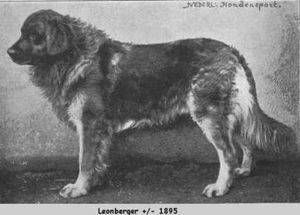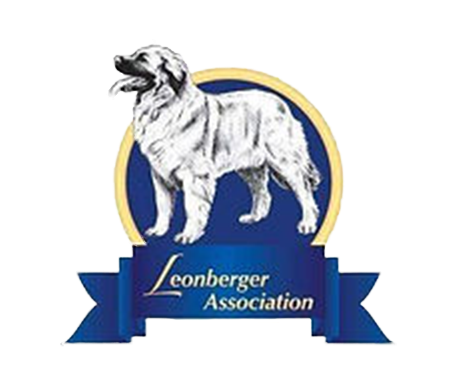ORIGINS OF THE BREED.....
The Leonberger is a giant dog breed. The breed's name derives from the city of Leonberg,Germany. According to legend, the Leonberger was ostensibly bred as a 'symbolic dog' that would mimic the lion in the town crest.
In the 1830's, Heinrich Essig, a dog breeder and seller and mayor of Leonberg claimed to have created the Leonberger by crossing a female Landseer Newfoundland with a "barry" male from the Great St Bernard Hospice and Monastery (which would later create the Saint Bernard breed). Later, according to Essig, a Pyrenean Mountain dog was added, resulting in very large dogs with the long white coats that were the fashion for the time, and pleasant temperament. The first dogs registered as Leonbergers were born in 1846 and had many of the prized qualities of the breeds from which they were derived. The popular legend is that it was bred to resemble the coat-of-arms animal of Leonberg, the lion.
The Leonberger dog became popular with several European royal households, including Napoleon II Empress Elizabeth of Austria, Otto Von Bismarck Emperor Napoleon III and Umberto I of Italy. Essig's claim of breeding the dog as described is disputed. At least as early as 1585, the royal household of Austrian Prince Franz Metternich, of Wolfberg, father of Prince Metternich, owned dogs of the same description. Either way, there is no doubt that Essig named and registered the breed first. A black and white engraving of the Leonberger was included in "The Illustrated Book of the Dog" by Vero Shaw in 1881. At the time, Essig's Leonbergers were denounced as an indifferent knockoff of a St. Bernard — not a stable and recognized breed — and a product of a popular fad or fashion for large and strong dogs, fomented in part by Essig's prodigious marketing skills (he gave dogs to the rich and famous).
The modern look of the Leonberger, with darker coats and a black masks, was developed during the latter part of the 20th century by re-introducing other breeds, such as the Newfoundland. This was necessary because breeding stocks of the leonberger were seriously affected by the two world wars. During World War 1 most Leonbergers were left to fend for themselves as breeders fled or were killed. Reportedly, only five Leonbergers survived World War I and were bred until World War II when, again, almost all Leonbergers were lost. During the two world wars, Leonbergers were used to pull the ammunition carts, a service to the breed's country that resulted in the Leonbergers' near-destruction.
Leonbergers today can have their ancestry traced to the eight dogs that survived World War II.

About The Breed
The Leonberger is a lush-coated giant of German origin. They have a gentle nature and serene patience and they relish the companionship of the whole family. A huge and powerful dog, yes, but the Leonberger is also known for his aristocratic grace and elegance. A male can stand over 31 inches at the shoulder and weigh as much as a full-grown human. Females run smaller but are still a whole lot of dog. Breed hallmarks include a medium-long waterproof coat, lush triangular ears, a bushy tail, and a black facemask that frames kindly dark-brown eyes. A dramatic feature of the male's coat is the lion-like mane around the neck and chest. A well-built Leo moves with an easy, elastic gait. A Leo is friendly but nobody's fool. As watchdogs and all-around workers, they exhibit intelligence and sound judgment. Leos require lots of brushing, ample room for romping, and unlimited love.
Health
As with all canines, proper exercise and nutrition, routine vet exams, and parasite prevention are keys to a happy and healthy life. Large dogs such as Leos can experience bloat, where the stomach twists and gas is trapped inside. Bloat can quickly be fatal, and it is important to know its signs, such as drooling, restlessness, enlarged abdomen, and attempts to vomit. Owners of at-risk dogs can consider the preventative measure of having their dog's stomach surgically tacked to the abdominal wall.
Grooming
Leonbergers shed a lot; and twice a year, they shed even more. A Leo should be brushed every day, especially in the areas of his body that tend to mat: the long hair behind the ears and on the backs of the legs. A more thorough grooming should be done once a week'and given the breed's size, this will take a fair amount of time. Leos have a thick, full outer coat and a shorter, fluffier undercoat. A metal comb and an undercoat rake can be used to work out the undercoat, and a pin brush and a slicker brush will neaten up the outer coat. In addition, a Leo's nailsshould be trimmed every other week.
Temperament
The Leonberger has a lively nature. It is brave, intelligent, steady and affectionate. It has a sweet expression. Loving and steadfast, stable and calm, the Leonberger just loves everyone. Its intelligence is extraordinary; its loyalty and love for its family is unparalleled. He has a friendly personality. A well-balanced Leonberger will be highly trustworthy and have incredible patience, even with the most obnoxious children. With most of these dogs, if the situation becomes too intense, instead of showing any aggression, the Leonberger simply walks away. Most of these dogs can take bad behavior in their stride. The Leonberger does not respond very well to harsh training methods; training requires patience. Owners need to be firm, but calm, confident and consistent. Proper canine communication is essential. To be an excellent watchdog requires some special training. Often called a gentle giant, the Leonberger is serious, eager and willing to please, responding well to training. The Leonberger can get along with other dogs. Socialize and train early, as this puppy will become a very large adult. Teach your dog to respect humans by training it not to jump, to heel on the lead and to enter and exit all door and gateways after the humans. The Leonberger is more active and coordinated than many other giant breeds.
Recommended Health Tests
- Hip EvaluationElbow EvaluationThyroid EvaluationOphthalmologist Exam (CERF)LPN1 DNA TestLPN2 DNA TestLEMP (Leukoencephalomyelopathy)
DNA Test
Exerise
If you live in a city apartment or a house on a small, suburban lot, this may not be the breed for you. Adult Leonbergers are generally calm and subdued, but they still need to have some vigorous exercise once a day. Puppies and adolescents are active and exuberant. Adult dogs can benefit from jogging or hiking with their owner or keeping pace alongside a bicycle. A large yard with a tall, strong fence is the ideal place for a Leo to run around. Remember, these are working dogs. Drafting'¿that is, pulling a cart'and agility training are two good ways for a Leo to get the activity he or she needs.
Training
Leonbergers are very large and strong. In addition, puppies and adolescents have loads of energy and are extremely enthusiastic. With these facts in mind, proper training of the breed is essential. Leo puppies should be socialized by being gently exposed to a wide range of people, animals, and settings before the age of 20 weeks. Group obedience classes will help a Leo learn to be a well-mannered companion and canine citizen. A Leo is probably stronger than and may even outweigh his owner, and it is imperative that he learns to do what you want him to do.












